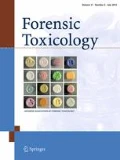Abstract
As a part of the work conducted in our laboratory, we encountered a case in which new chemical compound was contained in a certain product. This compound was found to have a molecular weight of 310 Da by liquid chromatography–mass spectrometry and gas chromatography–mass spectrometry. Accurate mass spectrometry measurements showed that the compound had an elemental composition of C16H26N2O2S. Using these mass data together with those obtained by nuclear magnetic resonance analysis and X-ray crystallographic analysis, this compound was identified as N-[3-(2-methoxyethyl)-4,5-dimethyl-2(3H)-thiazolylidene]-2,2,3,3-tetramethylcyclopropanecarboxamide, which was reported in 2009 and named A-836339. It was described as a thiazol derivative and a selective agonist of G-protein-coupled cannabinoid receptor CB2. This is the first report to identify this compound in a dubious product.




Similar content being viewed by others
References
EMCDDA (2013) “EMCDDA-Europol 2012 annual report on the implementation of council decision 2005/387/JHA”. EMCDDA/Europol, Lisbon http://www.emcdda.europa.eu/publications/implementation-reports/2012. Accessed May 2013
Uchiyama N, Kikura-Hanajiri R, Kawahara N, Haishima Y, Goda Y (2009) Identification of a cannabinoid analog as a new type of designer drug in a herbal product. Chem Pharm Bull 57:439–441
Uchiyama N, Kikura-Hanajiri R, Kawahara N, Goda Y (2009) Identification of a cannabimimetic indole as a designer drug in a herbal product. Forensic Toxicol 27:61–66
Uchiyama N, Kawamura M, Kikura-Hanajiri R, Goda Y (2010) Identification and quantitation of two cannabimimetic phenylacetylindoles JWH-251 and JWH-250, and four cannabimimetic naphthoylindoles JWH-081, JWH-015, JWH-200, and JWH-073 as designer drugs in illegal products. Forensic Toxicol 29:25–37
Nakajima J, Takahashi M, Seto T, Suzuki J (2011) Identification and quantitation of cannabimimetic compound JWH-250 as an adulterant in products obtained via the Internet. Forensic Toxicol 29:51–55
Nakajima J, Takahashi M, Seto T, Kanai C, Suzuki J, Yoshida M, Hamano T (2011) Identification and quantitation of two benzoylindoles AM-694 and (4-methoxyphenyl)(1-pentyl-1H-indol-3-yl)methanone, and three cannabimimetic naphthoylindoles JWH-210, JWH-122, and JWH-019 as adulterants in illegal products obtained via the Internet. Forensic Toxicol 29:95–110
Nakajima J, Takahashi M, Nonaka R, Seto T, Suzuki J, Yoshida M, Kanai C, Hamano T (2011) Identification and quantitation of a benzoylindole (2-methoxyphenyl)(1-pentyl-1H-indol-3-yl)methanone and a naphthoylindole 1-(5-fluoropentyl-1H-indol-3-yl)-(naphthalene-1-yl)methanone (AM-2201) found in illegal products obtained via the Internet and their cannabimimetic effects evaluated by in vitro [35S]GTPγS binding assays. Forensic Toxicol 29:132–141
Nakajima J, Takahashi M, Seto T, Yoshida M, Kanai C, Suzuki J, Hamano T (2012) Identification and quantitation of two new naphthoylindole drugs-of-abuse, (1-(5-hydroxypentyl)-1H-indol-3-yl)(naphthalen-1-yl)methanone (AM-2202) and (1-(4-pentenyl)-1H-indol-3-yl)(naphthalen-1-yl)methanone, with other synthetic cannabinoids in unregulated “herbal” products circulated in the Tokyo area. Forensic Toxicol 30:33–44
Uchiyama N, Kawamura M, Kikura-Hanajiri R, Goda Y (2012) Identification of two new-type synthetic cannabinoids, N-(1-adamantyl)-1-pentyl-1H-indole-3-carboxamide (APICA) and N-(1-adamantyl)-1-pentyl-1H-indazole-3-carboxamide (APINACA), and detection of five synthetic cannabinoids, AM-1220, AM-2233. AM-1241, CB-13 (CRA-13), and AM-1248, as designer drugs in illegal products. Forensic Toxicol 30:114–125
Kikura-Hanajiri R, Uchiyama N, Kawamura M, Goda Y (2013) Changes in the prevalence of synthetic cannabinoids and cathinone derivatives in Japan until early 2012. Forensic Toxicol 31:44–53
Uchiyama N, Kawamura M, Kikura-Hanajiri R, Goda Y (2013) URB-754: a new class of designer drug and 12 synthetic cannabinoids detected in illegal products. Forensic Sci Int 227:21–32
Nakajima J, Takahashi M, Seto T, Kanai C, Suzuki J, Yoshida M, Uemura N, Hamano T (2013) Analysis of azepane isomers of AM-2233 and AM-1220, and detection of an inhibitor of fatty acid amide hydrolase [3′-(aminocarbonyl)(1,1′-biphenyl)-3-yl]-cyclohexylcarbamate (URB597) obtained as designer drugs in the Tokyo area. Forensic Toxicol 31:76–85
Uchiyama N, Matsuda S, Wakana D, Kikura-Hanajiri R, Goda Y (2013) New cannabimimetic indazole derivatives, N-(1-amino-3-methyl-1-oxobutan-2-yl)-1-pentyl-1H-indazole-3-carboxamide (AB-PINACA) and N-(1-amino-3-methyl-1-oxobutan-2-yl)-1-(4-fluorobenzyl)-1H-indazole-3-carboxamide (AB-FUBINACA) identified as designer drugs in illegal products. Forensic Toxicol 31:93–100
Uchiyama N, Matsuda S, Kawamura M, Kikura-Hanajiri R, Goda Y (2013) Two new-type cannabimimetic quinolinyl carboxylates, QUPIC and QUCHIC, two new cannabimimetic carboxamide derivatives, ADB-FUBINACA and ADBICA, and five synthetic cannabinoids detected with a thiophene derivative α-PVT and an opioid receptor agonist AH-7921 identified in illegal products. Forensic Toxicol 31:223–240
Bruker Daltonics (2008) Bruker suite. Bruker AXS Inc., Madison
Sheldrick GM (2008) SADABS—Bruker AXS area detector scaling and absorption, version 2008/1. University of Göttingen, Göttingen
Sheldrick GM (1997) SHELXS-97, program for crystal structure solution. University of Göttingen, Göttingen
Sheldrick GM (1997) SHELXL-97, program for crystal structure refinement. University of Göttingen, Göttingen
Choi H, Heo S, Kim E, Hwang BY, Lee C, Lee J (2013) Identification of (1-pentylindol-3-yl)-(2,2,3,3-tetramethylcyclopropyl)methanone and its 5-pentyl fluorinated analog in herbal incense seized for drug trafficking. Forensic Toxicol 31:86–92
Shevyrin V, Melkozerov V, Nevero A, Eltsov O, Morzherin Y, Shafran Y (2013) Identification and analytical properties of new synthetic cannabimimetics bearing 2,2,3,3-tetramethylcyclopropanecarbonyl moiety. Forensic Sci Int 226:62–73
Zuba D, Geppert B, Sekuła K, Żaba C (2013) [1-(Tetrahydropyran-4-ylmethyl)-1H-indol-3-yl]-(2,2,3,3-tetramethylcyclopropyl)methanone: a new synthetic cannabinoid identified on the drug market. Forensic Toxicol 31:281–291
Yao BB, Hsieh G, Daza AV, Fan Y, Grayson GK, Garrison TR, El Kouhen O, Hooker BA, Pai M, Wensink EJ, Salyers AK, Chandran P, Zhu CZ, Zhong C, Ryther K, Gallagher ME, Chin C-L, Tovcimak AE, Hradil VP, Fox GB, Dart MJ, Honore P, Meyer MD (2009) Characterization of a cannabinoid CB2 receptor-selective agonist, A-836339 [2,2,3,3-tetramethylcyclopropanecarboxylic acid [3-(2-methoxy-ethyl)-4,5-dimethyl-3H-thiazol-(2Z)-ylidene]-amide], using in vitro pharmacological assays, in vivo pain models, and pharmacological magnetic resonance imaging. J Pharmacol Exp Ther 328:141–151
Acknowledgments
This work was supported in part by a research budget of the Tokyo Metropolitan Government, Japan.
Conflict of interest
These are no financial or other relations that could lead to a conflict of interest.
Author information
Authors and Affiliations
Corresponding author
Rights and permissions
About this article
Cite this article
Uemura, N., Fukaya, H., Kanai, C. et al. Identification of a synthetic cannabinoid A-836339 as a novel compound found in a product. Forensic Toxicol 32, 45–50 (2014). https://doi.org/10.1007/s11419-013-0201-x
Received:
Accepted:
Published:
Issue Date:
DOI: https://doi.org/10.1007/s11419-013-0201-x




